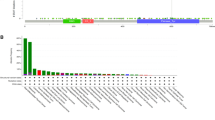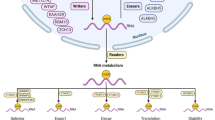Abstract
Background
Thyroid cancer is one of the most common endocrine malignancies. Although the 10-year survival rate of differentiated thyroid cancer (DTC) is about 90% after conventional treatments, a small proportion of patients still suffer from tumor recurrence or drug resistance.
Objective
This review article summarizes recent researches and clinical trials related to target drugs that reduce mortality in thyroid cancer.
Methods
This is a review of the recent literature and clinical trials on the three main aspects including methylation genes in thyroid cancers, the relationship between BRAF mutation and gene methylation, target and dehypermethylation drugs in clinical trials.
Results
We propose new approaches to treating malignant thyroid cancer, based on advances in understanding the relationship between genetic and epigenetic changes in thyroid cancer. Although the effect of traditional treatment for thyroid cancer is relatively good, a small proportion of patients still suffer from tumor recurrence or drug resistance. Molecular targeted drugs and dehypermethylation drugs have more promising outcomes in aggressive thyroid cancer compared with conventional treatments.
Conclusion
Based on what was discussed in this review, we suggest that integration of epigenetic and targeted therapies into conventional treatments will reduce the occurrence of refractory radioiodine differentiated thyroid cancer and improve the outcomes in aggressive thyroid cancer patients.
Similar content being viewed by others
References
Siegel R, Naishadham D, Jemal A (2013) Cancer statistics. CA Cancer J Clin 63(1):11–30
Sipos J, Mazzaferri EL (2010) Thyroid cancer epidemiology and prognostic variables. Clin Oncol (R Coll Radiol) 22(6):395–404
Torre LA T, Bray F, Siegel RL, Ferlay J, Lortet-Tieulent J, Jemal A (2015) Global cancer statistics, 2012. CA Cancer J Clin 65(2):87–108. https://doi.org/10.3322/caac.21262
Hundahl SA, Cady B, Cunningham MP, Mazzaferri E, McKee RF, Rosai J, Shah JP, Fremgen AM, Stewart AK, Hölzer S (2000) Initial results from a prospective cohort study of 5583 cases of thyroid carcinoma treated in the United States during 1996. US and German Thyroid Cancer Study Group. An American College of Surgeons Commission on Cancer Patient Care Evaluation study. Cancer 89(1):202–217
Cho BY, Choi HS, Park YJ (2013) Changes in the clinicopathological characteristics and outcomes of thyroid cancer in Korea over the past four decades. Thyroid 23(7):797–804
Pishkari S, Paryan M, Hashemi M, Baldini E, Mohammadi-Yeganeh S (2018) The role of microRNAs in different types of thyroid carcinoma: a comprehensive analysis to find new miRNA supplementary therapies. J Endocrinol Invest 41(3):269–283
Vu-Phan D, Koenig RJ (2014) Genetics and epigenetics of sporadic thyroid cancer. Mol Cell Endocrinol 386(1–2):55–66
Xing M (2005) BRAF mutation in thyroid cancer. Endocr Relat Cancer 12(2):245–262
Santos JC, Bastos AU, Cerutti JM et al (2013) Correlation of MLH1 and MGMT expression and promoter methylation with genomic instability in patients with thyroid carcinoma. BMC Cancer 13:79
Guan H, Ji M, Hou P et al (2008) Hypermethylation of the DNA mismatch repair Gene hMLH1 and its association with lymph node metastasis and T1799A BRAF mutation in patients with papillary thyroid cancer. Cancer 113(2):247–255
Zane M, Agostini M, Enzo MV et al (2013) Circulating cell-free DNA, SLC5A8 and SLC26A4 hypermethylation, BRAFV600E: a non-invasive tool panel for early detection of thyroid cancer. Biomed Pharmacother 67(8):723–730
Hu S, Liu D, Tufano RP et al (2006) Association of aberrant methylation of tumor suppressor genes with tumor aggressiveness and BRAF mutation in papillary thyroid cancer. Int J Cancer 119(10):2322–2329
Jones PA, Baylin SB (2002) The fundamental role of epigenetic events in cancer. Nat Rev Genet 3(6):415–428
Davis CD, Uthus EO (2004) DNA methylation, cancer susceptibility, and nutrient interactions. Exp Biol Med (Maywood) 229(10):988–995
Sun B, Hu L, Luo ZY et al (2016) DNA methylation perspectives in the pathogenesis of autoimmune diseases. Clin Immunol 164:21–27
Xing M (2007) Gene methylation in thyroid tumorigenesis. Endocrinology 148(3):948–953
Tang J, Xiong Y, Zhou HH, Chen XP (2014) DNA methylation and personalized medicine. J Clin Pharm Ther 39(6):621–627
Lv JF, Hu L, Zhuo W (2016) Epigenetic alternations and cancer chemotherapy response. Cancer Chemother Pharmacol 77(4):673–684
Ai S, Shen L, Guo J et al (2012) DNA methylation as a biomarker for neuropsychiatric diseases. Int J Neurosci 122(4):165–176
Liu MZ, McLeod HL, He FZ (2014) Epigenetic perspectives on cancer chemotherapy response. Pharmacogenomics 15(5):699–715
Stephen JK, Chen KM, Merritt J et al (2015) Methylation markers for early detection and differentiation of follicular thyroid cancer subtypes. Cancer Clin Oncol 4(2):1–12
Schagdarsurengin U, Gimm O, Hoang Vu et al (2002) Frequent epigenetic silencing of the CpG island promoter of RASSF1A in thyroid carcinoma. Cancer Res 62(13):3698–3701
Kunstman JW, Korah R, Healy JM (2013) Quantitative assessment of RASSF1A methylation as a putative molecular marker in papillary thyroid carcinoma. Surgery 154(6):1255–1261 (discussion 1261-2)
Stephen JK, Chen KM, Merritt J et al (2018) Methylation markers differentiate thyroid cancer from benign nodules. J Endocrinol Invest 41(2):163–170
Anania MC, Sensi M, Radaelli E et al (2011) TIMP3 regulates migration, invasion and in vivo tumorigenicity of thyroid tumor cells. Oncogene 30(27):3011–3023
Adamczewski Z, Makarewicz J, Mikosiński S et al (2006) Application of 13-cis-retinoic acid in patients with 131I scintigraphically negative metastases of differentiated thyroid carcinoma. Endokrynol Pol 57(4):403–406
Xing M (2010) Genetic alterations in the phosphatidylinositol-3Kinase/Akt pathway in thyroid cancer. Thyroid 20(7):697–706
Erol A (2012) Death-associated proliferation kinetic in normal and transformed cells. Cell Cycle 11(8):1512–1516
Hoque MO, Rosenbaum E, Westra WH et al (2005) Quantitative assessment of promoter methylation profiles in thyroid neoplasms. J Clin Endocrinol Metab 90(7):40118
Mohammadias J, Larijani B, Khorgami Z (2010) Qualitative and quantitative promoter hypermethylation patterns of the P16, TSHR, RASSF1A and RARb2 genes in papillary thyroid carcinoma. Med Oncol 28(4):1123–1128
Li H, Myeroff L, Smiraglia D et al (2003) SLC5A8, a sodium transporter, is a tumor suppressor gene silenced by methylation in human colon aberrant crypt foci and cancers. Proc Natl Acad Sci USA 100(14):8412–8417
Porra V, Ferraro-Peyret C, Durand C et al (2005) Silencing of the tumor suppressor gene SLC5A8 is associated with BRAF mutations in classical papillary thyroid carcinomas. J Clin Endocrinol Metab 90(5):3028–3035
Xing M, Usadel H, Cohen Y et al (2003) Methylation of the thyroid-stimulating hormone receptor gene in epithelial thyroid tumors: a marker of malignancy and a cause of gene silencing. Cancer Res 63(9):2316–2321
Neumann S, Schuchardt K, Reske A et al (2004) Lack of correlation for sodium iodide symporter mRNA and protein expression and analysis of sodium iodide symporter promoter methylation in benign cold thyroid nodules. Thyroid 14(2):99–111
Galrão AL, Sodré AK, Camargo RY et al (2013) Methylation levels of sodium–iodide symporter (NIS) promoter in benign and malignant thyroid tumors with reduced NIS expression. Endocrine 43:225–229
Galrão AL, Camargo RY, Friguglietti CU et al (2014) Hypermethylation of a new distal sodium/iodide symporter (NIS) enhancer (NDE) is associated with reduced nis expression in thyroid tumors. J Clin Endocrinol Metab 99(6):E944–E952
Mancikova V, Buj R, Castelblanco E et al (2014) DNA methylation profiling of well-differentiated thyroid cancer uncovers markers of recurrence free survival. Int J Cancer 135(3):598–610
Cai LL, Liu GY, Tzeng CM (2016) Genome-wide DNA methylation profiling and its involved molecular pathways from one individual with thyroid malignant/benign tumor and hyperplasia. Medicine (Baltimore) 95(35):e4695
Kimura ET, Nikiforova MN, Zhu Z et al (2003) High prevalence of BRAF mutations in thyroid cancer: genetic evidence for constitutive activation of the RET/PTC-RAS-BRAF signaling pathway in papillary thyroid carcinoma. Cancer Res 63:1454–1457
Ciampi R, Nikiforov YE (2005) Alterations of the BRAF gene in thyroid tumors. Endocr Pathol 16:163–172
Xing M, Westra WH, Tufano RP et al (2005) BRAF mutation predicts a poorer clinical prognosis for papillary thyroid cancer. J Clin Endocrinol Metab 90(12):6373–6379
Xing M, Alzahrani AS, Carson KA et al (2015) Association between BRAF V600E mutation and recurrence of papillary thyroid cancer. J Clin Oncol 33(1):42–50
Galuppini F, Pennelli G, Vianello F et al (2016) BRAF analysis before surgery for papillary thyroid carcinoma: correlation with clinico-pathological features and prognosis in a single-institution prospective experience. Clin Chem Lab Med 54(9):1531–1539
Durante C, Puxeddu E, Ferretti E et al (2007) BRAF mutations in papillary thyroid carcinomas inhibit genes involved in iodine metabolism. J Clin Endocrinol Metab 92(7):2840–2843
Xing M, Cohen Y, Mambo E et al (2004) Early occurrence of RASSF1A hypermethylation and its mutual exclusion with BRAF mutation in thyroid tumorigenesis. Cancer Res 64(5):1664–1668
Hu S, Liu D, Tufano RP et al (2006) Association of aberrant methylation of tumor suppressor genes with tumor aggressiveness and BRAF mutation in papillary thyroid cancer. Int J Cancer 119(10):2322–2329
Hou P, Liu D, Xing M (2011) Genome-wide alterations in gene methylation by the BRAF V600E mutation in papillary thyroid cancer cells. Endocr Relat Cancer 18(6):687–697
Khan MS, Pandith AA, Masoodi SR et al (2014) Epigenetic silencing of TSHR gene in thyroid cancer patients in relation to their BRAF V600E mutation status. Endocrine 47(2):449–455
Liu D, Hu S, Hou P et al (2007) Suppression of BRAF/MEK/MAP kinase pathway restores expression of iodide-metabolizing genes in thyroid cells expressing the V600E BRAF mutant. Clin Cancer Res 13(4):1341–1349
Choi YW, Kim HJ, Kim YH et al (2014) B-RafV600E inhibits sodium iodide symporter expression via regulation of DNA methyltransferase1. Exp Mol Med 46:e120
Schlumberger M, Sherman SI (2012) Approach to the patient with advanced differentiated thyroid cancer. Eur J Endocrinol 166(1):5–11
Hoftijzer H, Heemstra KA, Morreau H et al (2009) Beneficial effects of sorafenib on tumor progression, but not on radioiodine uptake, in patients with differentiated thyroid carcinoma. Eur J Endocrinol 161:923–931
Thomas L, Lai SY, Dong W et al (2014) Sorafenib in metastatic thyroid cancer: a systematic review. Oncologist 19(3):251–258
Ott PA, Hamilton A, Min C et al (2010) A phase II trial of sorafenib in metastatic melanoma with tissue correlates. PLoS One 5(12):e15588
Sosman JA, Kim KB, Schuchter L et al (2012) Survival in BRAF V600-mutant advanced melanoma treated with vemurafenib. N Engl J Med 366(8):707–714
Hauschild A, Grob JJ, Demidov LV et al (2012) Dabrafenib in BRAF-mutated metastatic melanoma: a multicentre, open-label, phase 3 randomised controlled trial. Lancet 380(9839):358–365
Flaherty KT, Puzanov I, Kim KB et al (2010) Inhibition of mutated, activated BRAF in metastatic melanoma. N Engl J Med 363(9):809–819
Kim KB, Cabanillas ME, Lazar AJ et al (2013) Clinical responses to vemurafenib in patients with metastatic papillary thyroid cancer harboring BRAF(V600E) mutation. Thyroid 23(10):1277–1283
Brose MS, Cabanillas ME, Cohen EE et al (2016) Vemurafenib in patients with BRAFV600E-positive metastatic or unresectable papillary thyroid cancer refractory to radioactive iodine: a non-randomised, multicentre, open-label, phase 2 trial. Lancet Oncol 17(9):1272–1282
Dadu R, Shah K, Busaidy NL et al (2015) Efficacy and tolerability of vemurafenib in patients with BRAF(V600E)-positive papillary thyroid cancer: M.D. Anderson Cancer Center off label experience. J Clin Endocrinol Metab 100(1):E77–E81
Fujiwara Y, Yamazaki N, Kiyohara Y et al (2018) Safety, tolerability, and pharmacokinetic profile of dabrafenib in Japanese patients with BRAF (V600) mutation-positive solid tumors: a phase 1 study. Invest New Drugs 36(2):259–268
Linnekamp JF, Butter R, Spijker R et al (2017) Clinical and biological effects of demethylating agents on solid tumours—a systematic review. Cancer Treat Rev 54:10–23
Provenzano MJ, Fitzgerald MP, Krager K et al (2007) Increased iodine uptake in thyroid carcinoma after treatment with sodium butyrate and decitabine (5-Aza-dC). Otolaryngol Head Neck Surg 137(5):722–728
Choi YW, Kim HJ, Kim YH et al (2014) B-RafV600E inhibits sodium iodide symporter expression via regulation of DNA methyltransferase 1. Exp Mol Med 46:e120
Gunda V, Cogdill AP, Bernasconi MJ et al (2013) Potential role of 5-aza-2-deoxycytidine induced MAGE-A4 expression in immunotherapy for anaplastic thyroid cancer. Surgery 154(6):1456–1462 (discussion 1462)
Author information
Authors and Affiliations
Corresponding author
Ethics declarations
Conflict of interest
The authors declare that they have no conflict of interest.
Ethical approval
This manuscript is a review of the literature and does not contain original research either on animal or on human subjects.
Informed consent
For this type of study, informed consent is not required.
Rights and permissions
About this article
Cite this article
Zhang, K., Li, C., Liu, J. et al. DNA methylation alterations as therapeutic prospects in thyroid cancer. J Endocrinol Invest 42, 363–370 (2019). https://doi.org/10.1007/s40618-018-0922-0
Received:
Accepted:
Published:
Issue Date:
DOI: https://doi.org/10.1007/s40618-018-0922-0




